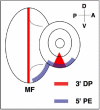Signaling in the third dimension: the peripodial epithelium in eye disc development
- PMID: 19623613
- PMCID: PMC2733925
- DOI: 10.1002/dvdy.22034
Signaling in the third dimension: the peripodial epithelium in eye disc development
Abstract
The eye-antennal imaginal disc of Drosophila melanogaster has often been described as an epithelial monolayer with complex signaling events playing out in two dimensions. However, the imaginal disc actually comprises two opposing epithelia (the peripodial epithelium, or PE, and the disc proper, or DP) separated by a lumen to form a sac-like structure. Recent studies expose complex molecular interactions between the PE and the DP, and reveal dynamic communication between the two tissues. Further findings suggest the PE makes important contributions to DP development by acting as a source of signaling molecules as well as cells. Here we summarize those findings and highlight implications for further research.
2009 Wiley-Liss, Inc.
Figures






References
-
- Baker NE. Transcription of the segment-polarity gene wingless in the imaginal discs of Drosophila, and the phenotype of a pupal-lethal wg mutation. Development. 1988;102:489–497. - PubMed
-
- Bessa J, Casares F. Restricted teashirt expression confers eye-specific responsiveness to Dpp and Wg signals during eye specification in Drosophila. Development. 2005;132:5011–5020. - PubMed
-
- Bodentstein D. The Postembryonic development of Drosophila melanogaster. In: Demerec M, editor. Biology of Drosophila. John Wiley and Sons, Inc.; New York: 1950. pp. 275–367.
-
- Bras-Pereira C, Bessa J, Casares F. Odd-skipped genes specify the signaling center that triggers retinogenesis in Drosophila. Development. 2006;133:4145–4149. - PubMed
-
- Cavodeassi F, Diez Del Corral R, Campuzano S, Dominguez M. Compartments and organising boundaries in the Drosophila eye: the role of the homeodomain Iroquois proteins. Development. 1999;126:4933–4942. - PubMed
Publication types
MeSH terms
Grants and funding
LinkOut - more resources
Full Text Sources
Molecular Biology Databases

